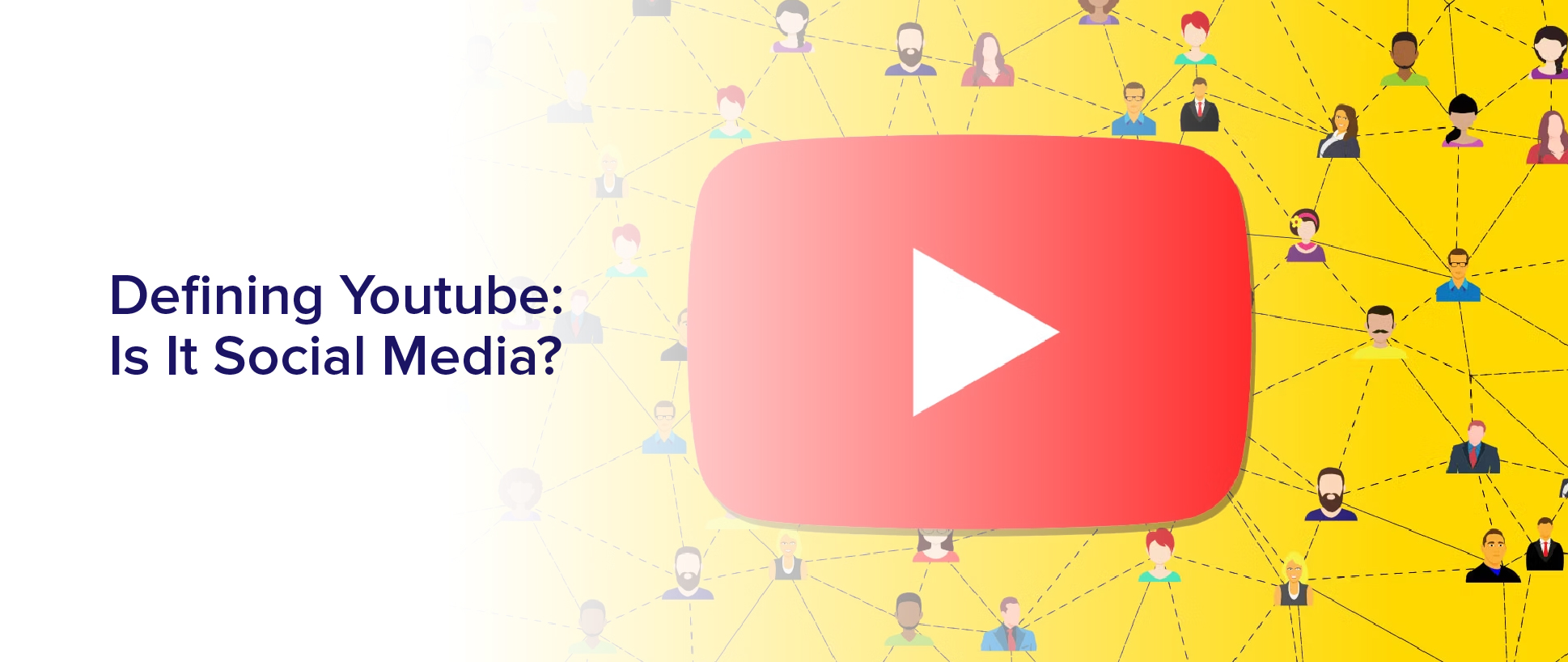Have you ever wondered if YouTube is really considered social media? It’s a question that has been debated for years, with some people arguing that YouTube is a unique platform that doesn’t fit into the traditional definition of social media. However, others argue that YouTube has all the characteristics of social media and should be treated as such.
In this article, we’ll explore the features and functions of YouTube, as well as the ways in which users interact with the platform, in order to determine whether or not YouTube can truly be considered social media.
As you probably already know, social media is a term that is used to describe websites and apps that allow users to create and share content, as well as interact with others. Some of the key characteristics of social media include user-generated content, the ability to share and comment on content, and the presence of social networks or communities.
While YouTube certainly allows users to create and share content, it doesn’t necessarily fit the mold of traditional social media platforms like Facebook or Instagram. So, the question remains: is YouTube really social media, or is it something else entirely?
Let’s find out.
Characteristics of Social Media
Social media is defined by its ability to facilitate user-generated content, encourage social interaction, and provide a platform for sharing information and opinions. It allows individuals to connect and engage with others, whether they’re friends, colleagues, or strangers.
Social media platforms have become a ubiquitous part of modern life, with billions of people using them every day to stay informed, entertained, and connected. One of the key characteristics of social media is that it’s interactive. Users can engage with content by liking, sharing, commenting, or even creating their own content. This creates a sense of community and fosters engagement and participation.
Additionally, social media allows for real-time communication, enabling users to interact with each other in a way that was previously impossible. Overall, social media is a powerful tool for communication, self-expression, and social engagement.
The Rise of YouTube
You can’t deny that you’ve spent countless hours scrolling through YouTube, watching everything from cat videos to makeup tutorials, and the platform’s popularity only continues to skyrocket.
In fact, YouTube is now the second most visited website in the world, with over 2 billion monthly active users. It’s hard to imagine a world without YouTube, but the platform only launched in 2005 and quickly became a game-changer in the world of online video.
YouTube’s success can be attributed to its user-generated content and the fact that it allows anyone to upload and share videos with the world. This has led to a diverse range of content, from educational videos to comedy sketches, and has given rise to numerous creators who have built careers and fan bases on the platform.
It’s clear that YouTube has revolutionized the entertainment industry and has become a key player in the world of social media, but the question still remains: is it really social media?
Features and Functions of YouTube
If you’re a fan of online video, chances are you’ve come across a platform that boasts a variety of features and functions that make it stand out from the rest. YouTube, the video-sharing giant, is a platform that allows users to upload, share, and view videos. It has become one of the most popular websites on the internet, with over 2 billion active users worldwide.
One of the unique features of YouTube is its ability to create a community around video content. Users can interact with one another through comments, likes, and shares, creating a social network of video enthusiasts. Additionally, YouTube offers a variety of tools for content creators, such as analytics, editing software, and monetization options.
With its vast library of videos and user-friendly interface, YouTube has become a staple of the online video landscape and continues to evolve and innovate.
User Interaction on YouTube
Interacting with fellow video enthusiasts on YouTube is a great way to discover new content and build connections with like-minded individuals. You can leave comments on videos, subscribe to channels, and like or dislike videos to show your appreciation or disapproval.
Additionally, you can share videos on other social media platforms or embed them on your own website. Another way to interact on YouTube is through live streaming. You can join live chats during streams and communicate with both the streamer and other viewers in real-time.
This is a great way to ask questions, share your thoughts, and engage in discussions. Overall, user interaction on YouTube is a key aspect of the platform and contributes to its social media-like nature.
Content Creation on YouTube
When creating content for your YouTube channel, it’s important to have a clear niche or focus that sets you apart from other creators. This can be achieved by choosing a specific topic or theme, such as beauty, gaming, or cooking, and consistently creating content around that theme. By doing this, you establish yourself as an authority in your chosen area and attract a dedicated audience who are interested in what you have to say.
In addition to having a clear niche, it’s important to create high-quality content that engages your audience. This can be achieved by using high-quality equipment, such as cameras and microphones, and by editing your videos to ensure they are visually appealing and easy to follow.
You should also aim to create content that is informative, entertaining, or both, and that provides value to your audience. By doing this, you’ll not only attract more viewers to your channel, but you’ll also keep them coming back for more.
YouTube vs. Traditional Social Media
You’re probably wondering how YouTube differs from other popular online platforms you may be using. It’s important to note that while YouTube does have social aspects such as commenting and sharing, it differs from traditional social media in significant ways.
Firstly, traditional social media platforms like Facebook and Twitter are primarily focused on connecting users with their friends and family, while YouTube is focused on content creation and discovery. Additionally, YouTube content creators have the ability to monetize their videos through advertising revenue, whereas traditional social media users do not have this option.
So while YouTube may have some social elements, it can’t be classified solely as a social media platform.
Frequently Asked Questions
How does YouTube’s algorithm determine which videos to recommend to users?
When you watch a video on YouTube, the algorithm takes note of what you’ve watched and how long you watched it for. It then uses this information to recommend similar videos that it believes you’ll enjoy.
The algorithm also takes into account factors such as the video’s title, description, and tags, as well as the engagement it has received from other users. This includes likes, comments, and shares.
Additionally, the algorithm considers your location, language, and device type to provide recommendations that are relevant and accessible to you.
The goal of the algorithm is to keep you engaged and watching videos on the platform for as long as possible.
What impact has YouTube had on traditional media outlets like television and radio?
YouTube has disrupted the traditional media landscape in a big way. With over 2 billion monthly active users, YouTube has become the go-to platform for video consumption, which has impacted how people consume content on television and radio.
Many traditional media outlets now have their own YouTube channels to reach a wider audience, but they also face stiff competition from independent content creators who produce high-quality videos that compete with mainstream programming.
YouTube has given voice to many creators who might not have been discovered by traditional media outlets, and it has also made it easier for audiences to find and enjoy content that they might not have otherwise been exposed to.
As a result, YouTube has changed the way we consume and interact with media, and it’s a trend that’s likely to continue in the years to come.
How do YouTube creators monetize their content and earn income from their channels?
To answer your question on how YouTube creators monetize their content and earn income from their channels, there are several ways.
One is through AdSense, where they earn a percentage of the revenue generated from ads displayed on their videos.
They can also earn through sponsored content, where they collaborate with brands to create videos promoting their products or services.
Some creators also offer merchandise or exclusive content for their fans through platforms like Patreon or their own websites.
Another way is through affiliate marketing, where they earn a commission for promoting products or services that their viewers end up purchasing.
Overall, there are multiple avenues for YouTube creators to earn a living from their content.
Can businesses effectively use YouTube as a marketing tool, and if so, how?
You’re probably wondering whether businesses can use YouTube as a marketing tool and, if so, how. The answer is yes, and there are several ways to do it effectively.
First, you can create your own channel and produce high-quality videos that showcase your products or services. You can also collaborate with popular YouTubers to feature your brand in their content.
Additionally, you can use YouTube ads to target specific audiences and drive traffic to your website. Whatever approach you take, it’s important to focus on creating engaging and informative content that resonates with your target audience.
With the right strategy, YouTube can be a powerful tool for building brand awareness and driving sales.
How has the rise of YouTube impacted the music industry, and what role does the platform play in promoting new artists?
The rise of Youtube has significantly impacted the music industry, serving as a crucial platform for promoting new artists.
With over 2 billion monthly active users, Youtube has become a go-to platform for discovering new music and accessing a diverse range of content. Through Youtube, artists can create and share their music videos, live performances, and interviews, connecting with fans worldwide.
Additionally, Youtube’s algorithm and recommendation system are designed to promote new and emerging artists, giving them exposure and recognition. As a result, many successful musicians have started their careers on Youtube, making it an essential tool for the music industry.
Conclusion
So, is YouTube social media? It’s a question that’s been debated for years, but after examining its characteristics and features, it’s clear that YouTube does indeed fall under the social media umbrella.
While it may not have all the traditional features of social media, such as direct messaging or status updates, YouTube offers a unique platform for user-generated content and interaction. Its ability to connect creators with a global audience, foster community through comments and collaborations, and provide a space for individuals to express themselves and build their personal brand all contribute to its social media status.
So whether you’re a casual viewer or a content creator, it’s worth acknowledging the impact and importance of YouTube in the world of social media.






